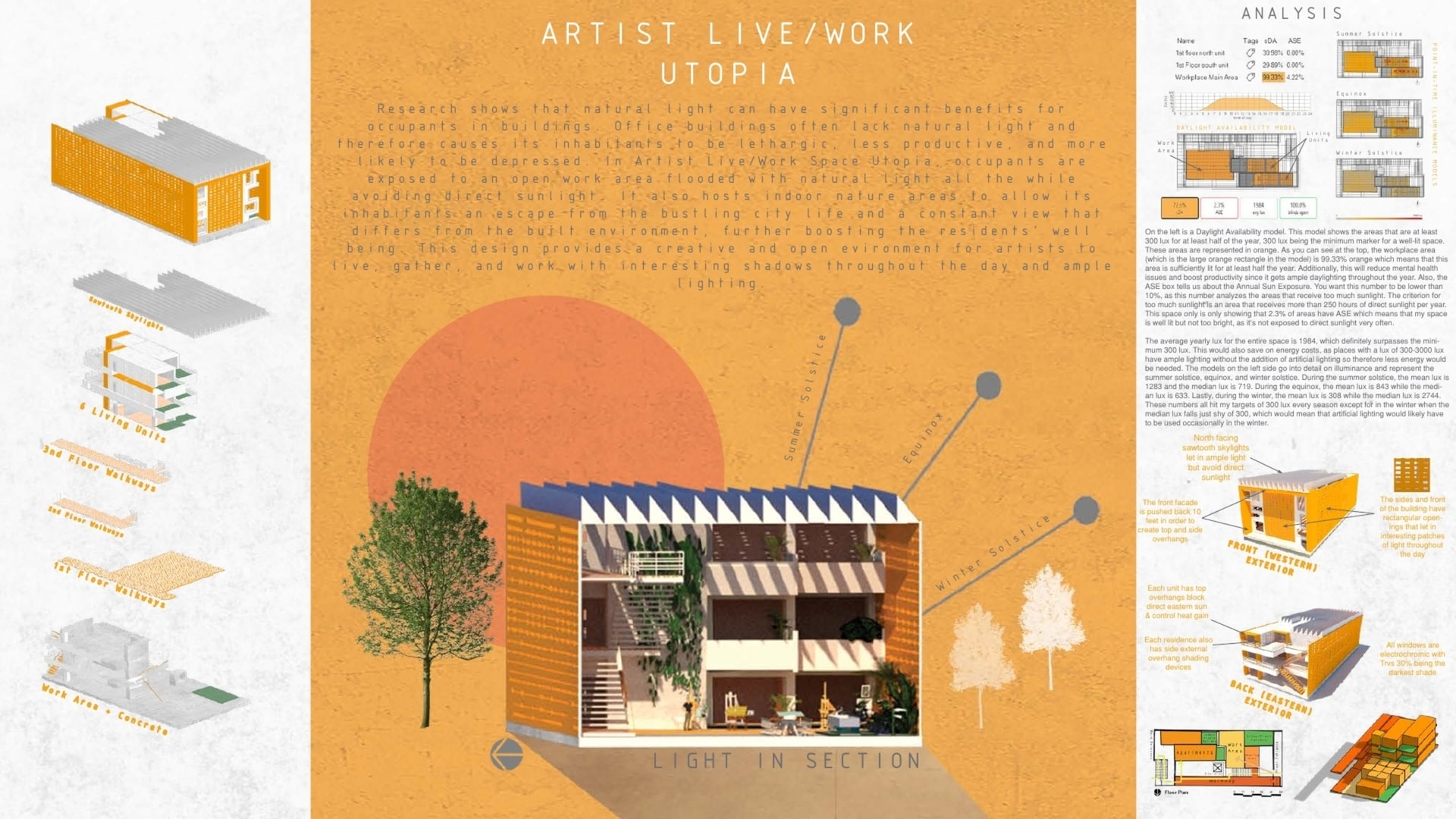Project Description
At a time where we spend most of our life in office buildings, it is more crucial than ever to reconsider the way they are designed. Many offices lack natural light to the point where it diminishes its occupants’ productivity and can even produce mental health issues. Additionally, many offices lack green space and are placed in cities that lack them as well, depriving its inhabitants of nature and forcing them to live instead in a concrete jungle. I have resolved these issues by creating a workspace that’s filled with natural light and compelling contrast while creating an indoor oasis of nature so that greenspace is always prevalent even in a big city. This project will be located in Denver, Colorado, and will be a work/live space for artists. My goal for this project was to average at least 300 lux which is the minimum number that denotes a well-lit space in accordance with the National Science Foundation. Additionally, I produce a creative space by implementing high-contrast shadows in the afternoons from the rectangular screen walls and sawtooth skylights. For views, the occupants each have their own apartment that looks onto the east back street with a huge window. Towards the west facade, there are large windows and a third-floor balcony that is public to all occupants and looks out onto the city streets. Inside, there will also be views, as there will be a grassy area near the workspaces with large plants growing from it near a pond. Each housing unit will also have an indoor balcony with its own grassy patch as well. My design concept is to use mostly concrete and tiling to make the space feel cooler in the summer. For windows, I will implement north-facing sawtooth skylights on the ceiling. On the eastern facade, housing units have large electrochromic windows that are also shaded from the sides and top with exterior shading devices to control heat gain. The western facade is pushed in about 9 feet in order to block sunlight and heat with external shading from the top and sides. All windows will be electrochromic. The electrochromic windows will range from clear to the darkest shade of glazing being Trvs 30%, Kawall 70mm. Additionally, both the north and south sides of the building along with the ceiling and the north sides of the housing units also have small rectangular perforations that allow for interesting shapes of light to come in. The rectangular openings in the walls also double as shelves to display artwork in. Inside the housing units, the rectangles act as top lighting and provide an effect as if the ceiling has many lights on it. For my analysis, you can see that during the winter and equinox, the work areas will have the proper amount of lux no matter what the season. There are a few patches in the living units that have a bit too much lux in the summer and equinox, but for the most part, occupants will be in the work area for the remainder of the day and therefore, this shouldn’t be a problem. The average yearly lux for the entire space is 1984, which definitely surpasses the minimum 300 lux. This would also save on energy costs, as places with a lux of 300-3000 lux have ample lighting without the addition of artificial lighting so therefore less energy would be needed. During the summer solstice, the mean lux is 1283 and the median lux is 719. During the equinox, the mean lux is 843 while the median lux is 633. Lastly, during the winter, the mean lux is 308 while the median lux is 2744. These numbers all hit my targets of 300 lux. Continuing my analysis, I performed a Daylight Availability study. The workplace area is 99.33% orange which means that this area is sufficiently lit for at least half the year. The ASE box tells us about the Annual Sun Exposure. This number indicates areas that receive too much sunlight. The criterion for this is an area that receives more than 250 hours of direct sunlight per year. To be considered for daylight credits, this number needs to be under 10%. This space only has 2.3% ASE which means that my space is well lit but not too bright, as it’s not exposed to direct sunlight very often. In conclusion, my project fosters a creative space filled with unique patterns of natural light that serves to create an artistic environment but also supports the occupants’ mental health and productivity. It will be a beautiful oasis of nature and light that allows for green space access even in a bustling city.
